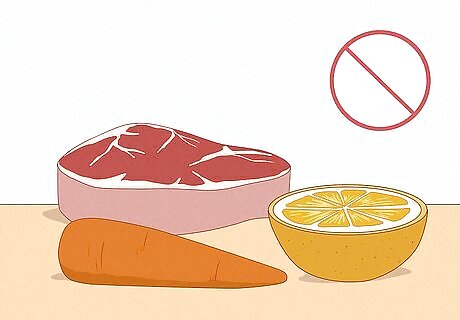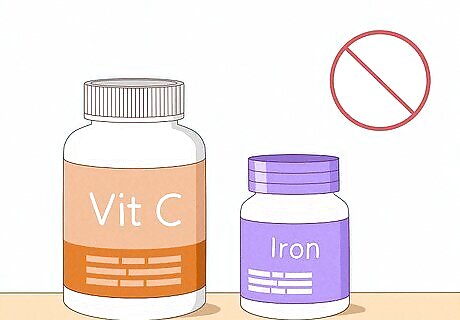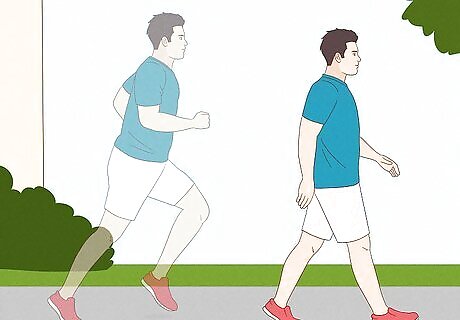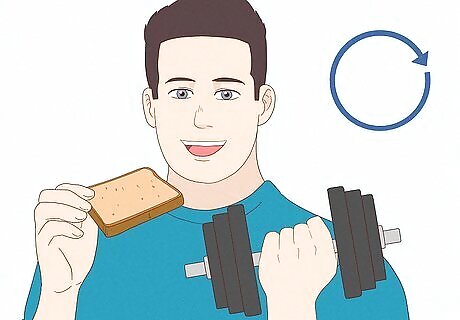
views
X
Trustworthy Source
Mayo Clinic
Educational website from one of the world's leading hospitals
Go to source
Thankfully, there are steps you can take at home to lower your ferritin levels quickly and improve your overall health at the same time. In this article, we’ll show you the best diet and exercise changes to make to get your ferritin back in the normal range.
- Reduce your iron consumption by eating less red meat and avoiding supplements or multivitamins with iron and vitamin C.
- Add iron-blocking foods like nuts and seeds, legumes, whole grains, and green tea to your diet to help lower your ferritin naturally.
- Stick to an exercise routine to lower ferritin levels. Start with walking, then gradually increase the length and intensity of your workouts and add weight training.
Adjusting Your Diet

Limit your consumption of red meat, vitamin C, and beta-carotene. Red meat has high concentrations of heme iron (iron from animal sources), which is more easily absorbed by the body. Absorption of heme iron also increases your body's absorption of nonheme iron (iron from plant-based foods). If you do choose to eat red meat, look for lower-iron sources like ground beef and cheap cuts. In addition to limiting red meats, stick to low-iron fish like cod or salmon (some fish, like tuna and mackerel, have high iron levels). Avoid uncooked fish, like in sushi or ceviche, and shellfish as well. Avoid eating red meat with foods high in vitamin C (like citrus fruits, tomatoes, and potatoes) or beta-carotene (like yellow, orange, and green leafy fruits and vegetables), which enhance iron absorption. Dark, leafy greens contain oxalates, which inhibit iron absorption. However, these greens also tend to have high levels of iron in them (like spinach).

Eat plenty of beans and legumes. Beans and legumes are high in phytates, a micronutrient that inhibits the absorption of iron. Avoid soaking or sprouting your beans before consumption, since this will reduce the phytate levels. Some tasty and healthy legumes include lentils, peas, chickpeas, peanuts, soybeans, and lima beans. Try to get 3-5 servings of beans and legumes per week (to lower ferritin and for your general health).

Choose whole-grain bread over white bread. Whole-grain bread has higher phytate concentrations than bread made with refined white flour. However, whole grains also contain more minerals, so check the iron content of any bread you buy to make sure iron levels aren’t high. In addition to whole-grain bread, eat other whole grain sources like barley, farro, quinoa, whole-grain pasta, and brown rice. Leavened bread has lower levels of phytates than unleavened bread. About 50% of most people’s phytate intake comes from whole grains, so eat up!

Have a glass of milk after meals to get more calcium and block iron. Calcium inhibits iron absorption, which can reduce the complications of the excess iron already present in your body. In addition to milk, try eating yogurt or hard cheese for a snack. Other calcium-rich foods that won’t up your iron include seeds, almonds, whey protein, and calcium-fortified beverages. If you're lactose-intolerant, drink mineral water infused with calcium during and after meals.

Drink green tea or coffee with or after meals. Green tea contains powerful antioxidants that bind to iron and prevent its absorption. If you plan on eating an iron-rich meal, drink a cup of green tea while you eat to lessen the effects on your ferritin levels. Black, peppermint, and chamomile teas also have iron-blocking properties. If you don’t enjoy tea, try coffee instead. It’s been shown to lower iron absorption after meals by almost 40%.

Snack on nuts and seeds throughout the day. Nuts and seeds, including walnuts, almonds, peanuts, and hazelnuts, inhibit your body's absorption of iron. In addition to a handful of nuts as a snack, try adding nuts to casseroles or putting nut butters (like peanut butter or almond butter) on sandwiches. Seeds, like sunflower seeds, flaxseeds, or chia seeds, also contain iron-blocking phytates. Coconuts have the same iron inhibitors as nuts and seeds, but in concentrations so low that they don’t have a significant effect on your body's iron absorption (they’re tasty and nutritious in other ways, though!).

Steer clear of nutritional supplements that contain iron and vitamin C. If you regularly take a multivitamin or other supplement, check the label carefully to make sure it does not include iron. The iron included in supplements is formulated to be especially easy for your body to absorb. Avoid iron-fortified foods, like fortified breads and breakfast cereals, too. Check the nutritional labels on any food you buy and avoid anything with added iron. Other metals, like zinc, manganese, and magnesium, are similar enough to iron that they can slightly inhibit iron uptake. If you take a multivitamin, make sure these metals are included. Vitamin C is often used as an immune booster to help fight colds. Swap your Emergen-C packet for a zinc lozenge instead, since zinc has similar cold-fighting abilities.

Reduce your alcohol intake significantly and quit smoking. Excessive amounts of alcohol combined with excessive iron can cause extensive damage to your liver. Higher than normal ferritin levels have been linked to alcohol abuse, and may be an early sign of liver disease. Studies also show that current and former smokers have higher ferritin levels than non-smokers. If you do drink alcohol, stick to red wine. It has micronutrients that inhibit iron absorption.
Getting Regular Exercise

Start a walking regimen if you’re not particularly active. Walking is a good way to get moving and build your overall physical strength and lower ferritin at the same time. Aim to walk at least 30 minutes a day (in addition to other physical activities) and to gradually increase the speed, distance, and time you spend walking. Stretch and warm up your body before any exercise, even something as low-impact as walking. In one study, participants significantly lowered their ferritin levels after completing three 1-hour walking sessions per week for 32 weeks. Escalating your walking to running may cause a greater reduction in ferritin levels, too.

Do weight or resistance training 3 times per week. Working out with weights increases your overall muscle strength as well as reduces your ferritin levels. In some studies, lower ferritin levels were detected in as little as 15 weeks. Try doing at least 40 minutes of strength training 3 times a week, along with your regular exercise routine. You may want to start with resistance training if you have a hard time with aerobic exercises, such as walking or running. If you're new to weight training, start out with a trainer or experienced lifter. They’ll make sure you have proper form to avoid injuring yourself.

Increase the intensity and duration of your exercise as you progress. Intense exercise (beyond regular, moderate exercise) has the greatest effect on ferritin levels. Try interval training or sign up for a HIIT (high-intensity interval training) class to engage in intense, prolonged training. Talk to your doctor about what types of training may be right for you, and to get recommendations for programs or professionals in your area that can help get you started. Try looking for free or low-cost guided HIIT workouts on YouTube or workout apps if you’d rather not pay for a class. High-intensity interval training can burn a significant amount of calories in a short period of time, as well as potentially reduce your ferritin levels. Athletes with normal ferritin levels have a high likelihood of developing an iron deficiency as a result of intense training.

Have patience with yourself while you lower your ferritin. If you’ve just started working out, it may take months or longer to affect your ferritin levels to a significant degree. Gradually increase the intensity of your exercise, stick to a low-iron diet, and continue to check your ferritin levels regularly to monitor your progress. Exercise or diet alone may not be enough to noticeably curb your ferritin. Employ both together for the best results. Remember that high ferritin is not usually a cause for immediate concern. Unless your doctor tells you otherwise, you have plenty of time to work on getting your levels down.



















Comments
0 comment